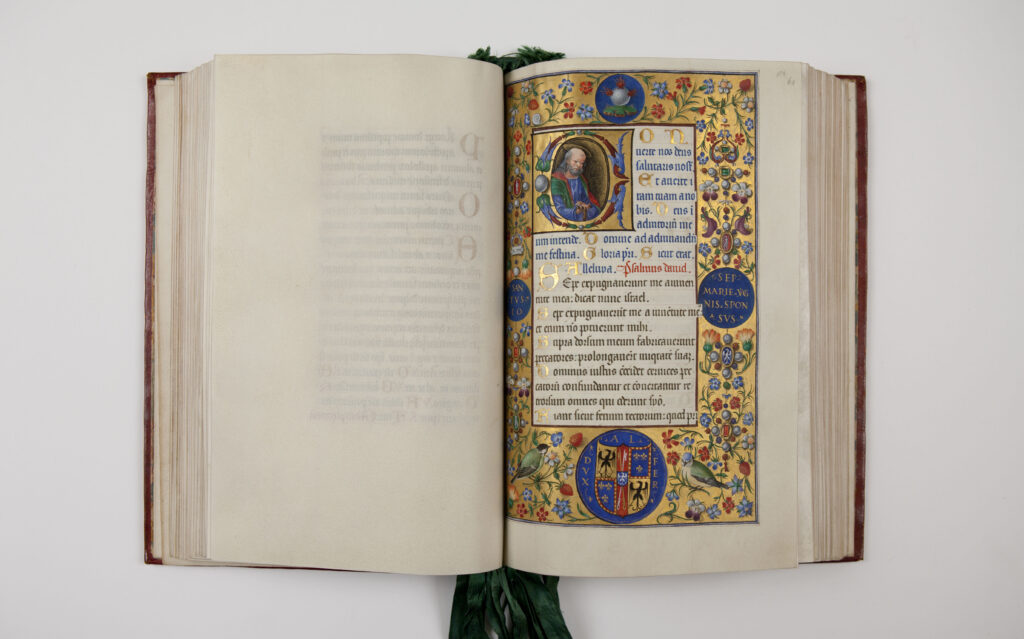In 1505, Alfonso I d’Este became Duke and commissioned an extraordinary miniated codex known as the ‘Offiziolo Alfonsino’ or the ‘Alfonso I Book of Hours’. The execution of this work is in continuity with his predecessors who had left masterpieces such as the Bible of Borso and the Breviary of Ercole I. The execution of the codex can probably be dated between 1505 and 1510-12 and is the result of the skill of the court miniaturist Matteo da Milano, who had previously worked on the Breviary of Ercole I.
Following the Devolution of Ferrara to the Papal State (1598), the codex was transferred to Modena, where it remained until the 19th century when it was first removed to protect it from the Napoleonic invasion and later in 1859 at the time of the definitive abandonment of Modena by the Este family. The codex followed the fate of Francesco V, who was forced into exile first to the Catajo Castle (Padua) and then to Vienna. Before 1870, fourteen full-page miniatures were removed from the Offiziolo, which are currently kept at the Strossmayerova Galerija in Zagreb, while the codex is at the Museu Calouste Gulbenkian in Lisbon. After the First World War, it was sold on the antiquities market by Duchess Zita of Borbone-Parma, widow of Emperor Charles I, to the Armenian collector Calouste Gulbenkian.
The codex is the duke’s private prayer book. The first pages are devoted to the Roman calendar with an indication of saints, liturgical feasts and practical advice on diet and health. Next comes the more devotional part, that of the Liturgy of the Hours, which determines the times and moments dedicated to prayer during the day.
The first miniated page highlights the figure of the Duke: in the upper part the most famous of his feats is depicted, namely the flaming grenade; the gold-ground frame is a riot of coloured flowers, birds, strawberries, pearls, gems and cameos. In the centre, the Duke is portrayed in armour with his bearded face marked by fatigue turned in prayer towards God who appears above him. On the opposite side are his titles in gold lettering on a blue background ‘AL (FONSUS) DUX FERRARIAE III’. The text accompanying the image is the believer’s plea not to be abandoned in adversity by the Lord and to be preserved from the wicked. The meaning of this supplication may conceal an allusion to the tension with the Papal States, which severely occupied Alfonso throughout his rule. The page closes with the Este coat of arms placed between two fanciful phytomorphic figures.
The full-page miniatures are conceived as works in their own right: the composition and pictorial quality make these sheets true masterpieces. Among the most incisive is the one depicting ‘Death Grasping a Pope’, which deals with the delicate subject of the clash between Alfonso I and the Pontiff. Death, personified by a skeleton with a bow and arrows and a very long scythe, is intent on reaping victims and is depicted just as he manages to rest a hand on the Pontiff’s shoulder. The latter, depicted in profile, turns his gaze to Death and is portrayed with a beard: this could allude to the beard that Pope Julius II had grown as a vow in October 1510. The inscription ‘Vide quanta sunt selera’ (see how many crimes) on the open book in the Devil’s hand is also interpreted as a note of hostility towards Julius II. By that time the Pontiff had already excommunicated Alfonso, interdicted Ferrara and personally led the ecclesiastical troops in battles against the Duchy, only his death in February 1513 managed to arrest his advance.
The Book of Hours commissioned by Duke Alfonso I can be considered the last masterpiece of miniature work by the Este family, which will never again be able to match the extraordinary works executed previously.










